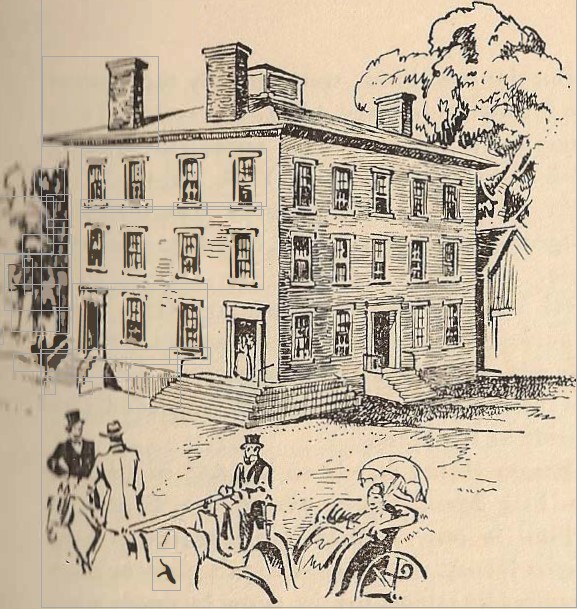|
killled in action was Henry A. Darby. He had been promoted to Captain only to lose his life on almost the last day of the war at Farmville, ·Va., April 8, 1865. Darby Post No. 359 G. A. R. was named in his honor. ★
In many ways, it was a time of ·stress for those at home as well as for the men at the front. Prices were rising—kerosene was 50¢ a gallon-and frugal living was necessary. Then, in the spring of 1861 there was another bad flood of the Cattaraugus that washed out the covered bridge, which had been built after the f1re. It was carried down to a point oppositc the Gowanda Union School. During this flood a great deal of the south bank of the c:rcck was washed away and several stores were destroyed. The bridge was brought back and replaced in 1862, on strengthened abutments. In the meantime seven temporary bridges had been washed out. Before the stores on Water Street could be rebuilt it was necessary to refill the road and creek bank. The Free Methodist Church was built in 1862. The Gowanda Agricultural, Horticultutal and Mechanical Society was organized in 1865. It purchased twenty acres of ground |
west of lower Broadway for ''The Fair Grounds." Annual fairs were held there until 1875 and horse races were always a great feature. The Pine Hill Cemetery was incorporated in 1867. The name of the newspaper was changed from the ''Gowanda Reporter'' in 1865 to the ''Gowanda Weekly Bulletin'' with a further change to the ''Gowanda Gazette'' in 1867. Joseph Herdeg moved to Gowanda in 1862 and started his well known wagon shop. Peter Rink bt1ilt a three story building on Buffalo Street near the foundry in 1865. The leading hotels immediately following the war were the Barker House, The Eagle Tavern and the Union Hotel. Sellew & Popple were making agricultural implements. Harmon Kelley had a marble finishing works. John Kammerer took over the Chaffee hardware business in 1868 and conducted a large store for many years. the mills of R. Plumb & Son continued to expand, doing a growing business in flour meal, feed and lumber. Despite tl1e period of high prices that prevaiJed during the war, and the many men who died or were disabled in the conflict, the village continued to grow. |
|
Page Forty-five |
|
Centennial Times |
|
|
THE decade of 1870 was a time of much solid progress in Gowanda. This was the period when the railroad came to the village, the opening of the first bank, and the reincorporation of the village to include the boundaries of Hidi. In the original plans for the railroad, it was intended to bring the line in on the west side of the village. Land for that purpose was bought around 1870 and construction work was started, which can still be seen in the hill at the rear of the home of Clarence Wells on Perrysburg Hill. However, a change was made in the eventual right of way and the railroad, |
as constructed, entered the village on the east side as it does at the present time. The Buffalo & Jamestown Railroad, as it was originally known, was formally opened to Gowanda traffic on October 24th, 1874. The first railroad bridge over the Cattaraugus had been completed the previous week, the first train crossing the bridge on October 17th. The contracted price for the construction of the road was $33,000 per mile. On the day of the railroad opening, an excursion train of eight cars came from Buffalo carrying that city's mayor, L. P. Dayton, and many officials and railroad executives. ttAn elegant dinner, under the charge of the ladies |
|
Page Forty-six |
|

The Mansion House was built in about 1836 by Phineas Spencer and managed by Zebedee Macomber. It was located on the corner and was occupied by The Bank of Gowanda. It was burned in the fireof 1856
of the village, was spread in the depot''. The name of the locomotive was the "Eden". J. E. Van Deusen was the first station agent. The opening of the railroad naturally ended most of the stagecoach travel through Gowanda |
It gave a fresh impetus to the growth of the community, many people moving to the village from the neighboring towns of Taylor Hollow and Bagdad . Gowanda had gained its first bank the preceding year. It was organized as J. S. Bartlett & Company and was located in the building now occupied by Whiting's store on West Main Street. A check dated December 11, 1876, bears the name of "The Gowanda Bank'', although it was generally referred to as "John Bartlett's Bank''. This institution served the villagt: until 1881. It was soundly managed and there were no losses to the investors. ★
The need for such a bank had become painfully evident. There had been a number of "private bankers'' who had employed unscrupulous methods and caused losses of hundreds of thousands of dollars to the people of the community. The days of "trade and barter'' commerce were practically over, currency was in general use, and the village was glad to have a bank in which it could place its confidence as well as its money. Fire was still a serious menace in the village. |
|
Page Forty-seven |
|